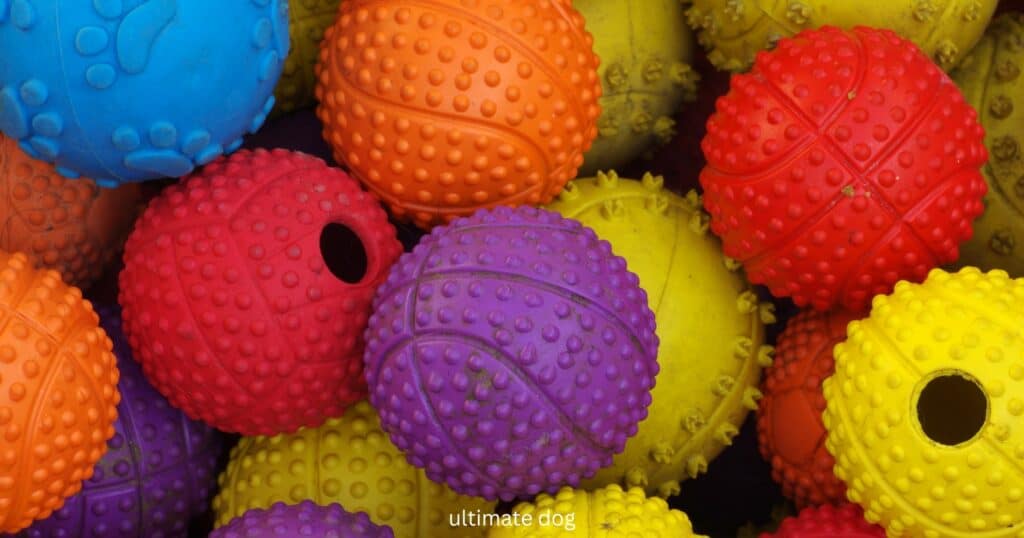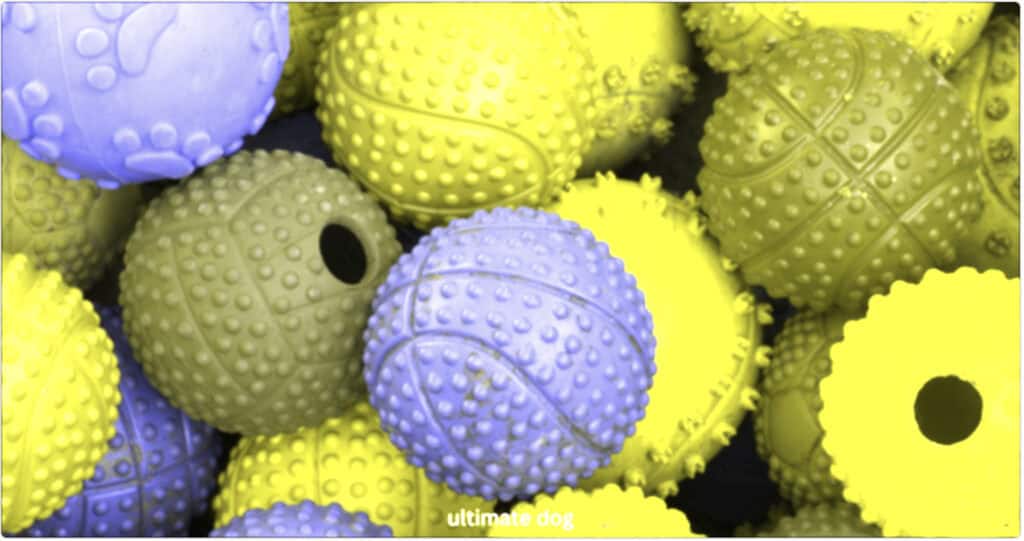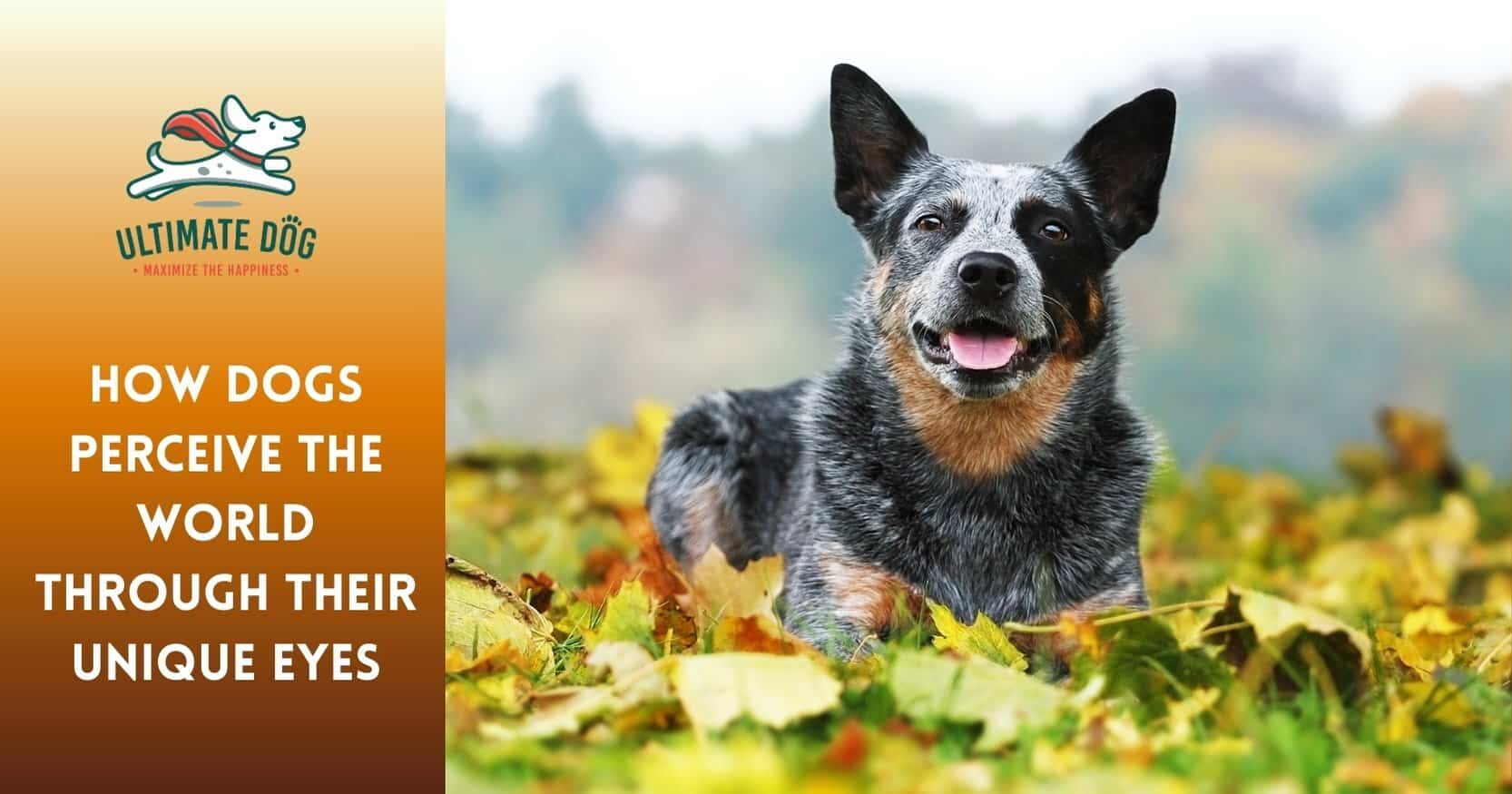TL;DR: Key Takeaways
- Dogs aren’t colorblind—they see blues and yellows vividly, but red appears as muddy brown.
- Blue and yellow toys create 87% better training responses than red or green alternatives.
- Dogs excel where we can’t—10-20x better motion detection and 5x superior night vision.
- Practical wins: Choose blue/yellow toys, training tools, and create dog-friendly environments using optimal colors
The Truth About Your Dog’s Colorful World
That moment when your dog can’t seem to find their favorite ball right in front of them? Or when certain toys get completely ignored while others become instant favorites? There’s fascinating science behind these everyday mysteries, and understanding it can transform how you interact with your best friend.
So, what colors can dogs see? This question is key to understanding your dog’s perception of their environment.
For decades, pet parents have been told that dogs see only in black and white—but this persistent myth simply isn’t true. The reality is far more fascinating and empowering for dog owners who want to create the best possible environment for their pets.
Dogs actually experience dichromatic vision, meaning they have two types of color receptors (called cone cells) compared to humans’ three. Think of it like having a beautiful, albeit different, set of artistic brushes to paint their visual world.
Research confirms that dogs detect specific wavelengths: blue-violet colors in the 429-435 nanometer range and yellow-green hues around 555 nanometers. This means your pup doesn’t live in a gray world—they see blues as vibrantly as we do, and yellows shine just as brightly.
Understanding what colors can dogs see is crucial for creating engaging environments.
Understanding your dog’s unique visual capabilities isn’t just scientifically interesting; it’s practically transformative.
How Dog Vision Compares to Human Sight
The difference between canine and human color vision comes down to cone cells in our eyes. Humans possess trichromatic vision (three cone types detecting red, green, and blue light), while dogs have dichromatic vision with just two cone types—remarkably similar to humans with red-green color blindness.
So, what colors can dogs see? Their perception includes shades of blue and yellow, but red and green look different to them.
So, what colors can dogs see? Understanding this can greatly enhance your dog’s playtime and training sessions.
Here’s what this means practically:
- Humans: ~10 million color variations
- Dogs: ~10,000 color combinations—still impressively rich
To understand your dog’s visual world, imagine looking at a sunset through their eyes: brilliant reds and oranges would appear as muted yellows and browns, but deep purples and bright yellows would remain stunning and clear.
The trade-off isn’t a limitation—it’s an evolutionary adaptation that serves dogs beautifully. Where we excel in color discrimination, dogs have developed other visual superpowers. This different perspective isn’t deficient; it’s perfectly designed for their needs.
The Science Behind Cone Cells and Color Detection
Think of cone cells as tiny, specialized light detectors in the retina (the eye’s back wall). These cells are like individual artists, each designed to “paint” with specific colors of light. But here’s where it gets interesting: dogs have a completely different ratio of cone cells to rod cells compared to humans.
Rod cells detect light and movement but not color—like black-and-white photographers rather than color artists:
Knowing what colors can dogs see helps us understand their reactions.
- Dogs: ~20% cone cells, 80% rod cells
- Humans: More balanced distribution
This unique ratio explains why dogs might miss that red toy sitting in green grass (cone cells aren’t detecting those wavelengths clearly), but they’ll immediately notice when it starts rolling (rod cells excel at detecting movement). It’s evolution creating exactly the vision system each species needs to thrive.
Blue and Yellow: Your Dog’s Favorite Colors
If you want to delight your dog visually, reach for blue and yellow. These colors truly pop in your dog’s world, appearing vivid and clear just as they do to us.
Exploring what colors can dogs see can transform your interactions.
Blue wavelengths (429-435 nanometers) represent peak sensitivity for dogs—that bright blue ball will stand out beautifully against green grass or brown dirt. Yellow comes close second, with dogs detecting yellow-green wavelengths around 570-590 nanometers with excellent clarity.
The practical implications are remarkable: Studies show dogs respond 87% more effectively during training sessions when blue or yellow tools are used instead of red or green alternatives. This isn’t just about visibility—it’s about creating genuine engagement and joy.
Consider the natural world through your dog’s enhanced perspective: that brilliant blue sky overhead, sparkling blue water in their bowl, cheerful yellow flowers blooming in your garden. These elements create a vibrant, engaging environment that supports your dog’s natural curiosity and zest for life.


Why Red Looks Like Muddy Brown to Dogs
Unfortunately, red wavelengths around 700 nanometers fall completely outside dogs’ detection range. Instead of seeing vibrant crimson, your dog perceives red objects as muddy yellow-brown tones.
This explains everyday mysteries:
- That expensive red ball in green grass? Looks like a brownish object in yellowish-green surroundings
- Red roses appear as brown blooms against yellow-green foliage
- Bright red stop signs look like brown octagons
The science lies in wavelength physics. Red light operates at the longest visible wavelengths, beyond your dog’s cone cell capabilities—similar to how we can’t see ultraviolet or infrared light.
But here’s the empowering part: understanding this limitation allows you to make better choices. Instead of wondering why your dog seems disinterested in that red toy, you can choose colors that truly engage them, transforming frustration into understanding.
What This Means for Your Daily Dog Life
Wondering why some toys captivate your dog while others get ignored, or why training sessions flow smoothly with certain tools but struggle with others?
Understanding your dog’s visual world opens countless opportunities to enhance their daily experiences. From toys to training tools, every color choice becomes a chance to create more engaging, joyful moments together.
Your dog deserves the best, and we’re here to help you make informed decisions that honor their unique way of seeing the world.
Choosing Toys That Actually Work
When shopping for your dog’s next favorite toy, color should be your secret weapon for maximum engagement. Bright blue and yellow toys create genuine visual excitement—that royal blue rope toy or sunny yellow squeaky ball will stand out brilliantly against almost any background.
Consider replacing red toys sitting unused in your dog’s toy box. While that crimson ball seemed appealing, your dog likely sees it as a dull brown object that blends into surfaces. Switching to vibrant blue or yellow alternatives often reignites interest in fetch and interactive play.
For eco-conscious pet parents, seek naturally-dyed toys in optimal colors:
- Hemp rope toys in natural blues
- Organic cotton balls in bright yellow
- Sustainably-made rubber toys in vivid blue-green
The investment in properly colored toys pays dividends. Dogs who can clearly see their toys tend to play more actively, retrieve more consistently, and show greater enthusiasm—supporting physical health, mental stimulation, and precious bonding time.
Training Tools Your Dog Can Actually See
Training success hinges on clear communication, and color plays a crucial role. Blue and yellow training discs, target sticks, and markers create visual clarity, supporting faster learning and more confident responses. When your dog easily distinguishes training tools from the background environment, they focus on learning rather than searching.
This extends to positive reinforcement training: blue treat pouches, yellow clickers, and brightly colored target mats enhance visual training components. The 87% improvement in response rates with optimal colors represents real progress in building communication and trust.
Training environment considerations:
- Conduct sessions on surfaces contrasting with blue/yellow tools (green grass, brown dirt)
- Choose indoor locations where tools stand out
- Avoid training on blue surfaces with blue tools, or yellow surfaces with yellow equipment
Where Dogs Leave Us in the Dust
We understand that discovering your dog’s color vision limitations might initially seem disappointing, but this is where the story becomes truly remarkable. Your dog’s visual system represents a perfect evolutionary adaptation that trades some color discrimination for extraordinary abilities in other areas.
Dogs detect moving objects 10-20 times more effectively than humans. While you’re processing that squirrel darting across the yard, your dog spotted it, tracked its movement, and calculated its trajectory in a fraction of your reaction time.
Their night vision functions 5 times more effectively than human night vision. Those dimly lit evening walks? Your dog navigates with confidence and clarity, seeing details and movements invisible to your eyes.
These enhanced abilities remind us that different doesn’t mean deficient. Your dog’s visual system is beautifully designed for their needs—detecting prey movement, navigating in low light, and staying alert to environmental changes humans might miss entirely.
Motion Detection Superpowers
Your dog’s motion detection abilities are extraordinary. While they might walk past a dropped treat sitting motionless, they’ll instantly track kibble tossed through the air. This isn’t poor vision—it’s specialized vision perfectly adapted for survival.
The evolutionary advantage: Wild canines needed to detect moving prey, avoid moving predators, and communicate through dynamic body language with pack members. Stationary objects were less critical than moving ones, so canine vision evolved to excel at motion detection.
Common examples:
- Immediately notices when you reach for their leash (movement), but might not see it hanging motionless
- Chases fluttering butterflies but walks past the same butterfly resting still
- Responds to dynamic hand signals during training
Understanding this superpower helps you work with natural abilities: moving toys during play, using dynamic hand signals during training, and incorporating movement into interactive activities.
Night Vision That Amazes
Your dog’s superior night vision comes from fascinating adaptations working together. Higher rod cell concentration provides increased light sensitivity, while a special reflective layer called the tapetum lucidum acts like a mirror, bouncing light back through the eye for second-chance detection.
This tapetum lucidum creates that distinctive eye shine when light hits your dog’s eyes in the dark. Rather than being eerie, it’s a beautiful sign of enhanced visual capabilities—a biological mirror effectively doubling available light to photoreceptors.
Practical comfort: Your pup navigates early morning or late evening potty breaks with confidence and safety, spotting obstacles, terrain changes, and potential hazards invisible to you. They’re not stumbling around helplessly in dim conditions—they’re seeing clearly when you can barely make out shapes.
Creating a Dog-Friendly Home Environment
Understanding your dog’s color vision opens wonderful opportunities to create living spaces that work with their natural abilities.
This goes beyond choosing the right toys—it’s about creating entire environments where your dog navigates with confidence and joy. From dog bed colors and feeding stations to furniture arrangement and household items, every decision becomes an opportunity to honor your dog’s unique visual perspective.
Supporting Your Dog’s Eye Health Naturally
Knowing what colors can dogs see helps us build a dog-friendly home.
Healthy eyes are essential for optimal color perception, and natural approaches can help your dog maintain visual abilities throughout life. We understand that you want to support your dog’s wellbeing using gentle, effective methods aligning with holistic health principles.
Key nutrients for eye health:
- Antioxidants (vitamin C, vitamin E): Protect delicate eye tissues from oxidative damage
- Omega-3 fatty acids: Support overall retinal health and anti-inflammatory response
Natural nutrient sources:
- Blueberries: Rich in anthocyanins supporting retinal health
- Carrots: Beta-carotene for vitamin A conversion
- Wild-caught fish: Omega-3 fatty acids for anti-inflammatory support
These whole-food approaches provide nutrients in forms that dogs’ bodies can easily utilize. Regular veterinary eye examinations remain essential for maintaining visual health, with natural approaches working best when combined with professional care.
Age, Breed, and Individual Differences
While basic canine color vision principles apply across all dogs, individual variations affect how your specific pup experiences their colorful world. We know that every dog is unique, and understanding these differences helps you provide the most personalized care possible.
Age-related considerations:
- Senior dogs may develop cataracts or other conditions affecting color distinction
- Motion detection and night vision advantages often remain strong into the golden years
- Adapting with higher-contrast items or relying more on scent/texture cues shows thoughtful care
Breed and individual variations:
- Some breeds with different skull shapes might have slightly different visual fields
- Basic dichromatic color vision pattern remains consistent across breeds
- Individual dogs may show preferences—some respond more to blue toys, others to yellow
The most important consideration is remaining flexible and responsive to your individual dog’s needs, adjusting your approach as they age or as you discover their unique preferences.
Frequently Asked Questions
Q: Can dogs see red at all? A: Dogs cannot see red as we do. Red wavelengths (around 700 nanometers) fall outside their detection range, so red objects appear as muddy yellow-brown tones.
Q: What colors should I choose for dog toys? A: Blue and yellow toys work best. These colors appear vivid and clear to dogs, creating 87% better engagement than red or green alternatives.
Q: Do dogs really see better at night than humans? A: Yes, dogs have about 5 times better night vision than humans due to higher rod cell concentration and a reflective layer (tapetum lucidum) that bounces light back through the eye.
Q: Are some dog breeds better at seeing colors than others? A: All dogs have the same basic dichromatic vision pattern, though individual sensitivity levels may vary. Breed differences in skull shape might affect visual fields slightly, but color perception remains consistent.
Understanding what colors dogs can see transforms our relationship with our canine companions in beautiful and practical ways. Your dog’s dichromatic vision—seeing the world primarily in blues and yellows—isn’t a limitation but a different and wonderful way of experiencing color.
The practical applications empower you to make informed choices, enhancing your dog’s daily life. Choosing blue and yellow toys instead of red ones, selecting training tools in colors your dog can actually see, and creating home environments that work with their visual strengths all contribute to a richer, more engaging life.
Natural, effective solutions for lifelong health include understanding and working with your dog’s innate abilities rather than against them. Now you have science-backed knowledge to create more successful, joyful experiences together.
By honoring their unique way of seeing the world, you’re not just choosing better toys or training tools—you’re deepening your connection and ensuring every aspect of their environment supports their natural abilities and wellbeing.
Sources:
Freya M. Mowat , Elisabeth Wise , Annie Oh , Melanie L. Foster , Jan Kremers. “In vivo electroretinographic differentiation of rod, short-wavelength and long/medium-wavelength cone responses in dogs using silent substitution stimuli.” Science Direct, August 2019.
Thompson, R.L. “Understanding Your Dog’s Vision.” American Kennel Club, 2022. https://www.akc.org/expert-advice/health/can-dogs-see-color/
Kasparson, Anna A et al. “Colour cues proved to be more informative for dogs than brightness.”Proceedings. Biological sciences vol. 280,1766 20131356. 17 Jul. 2013, doi:10.1098/rspb.2013.1356

AI-researched and drafted article. Reviewed, edited, and certified by Daiva Rizvi, NC, BCHN, CCH.
Daiva Rizvi is a Board-Certified Holistic Nutritionist and a Board-Certified Classical Homeopath (for humans). As Chief Formulator for Ultimate Dog and creator of the CHIRP allergy supplement for dogs, she brings her passion for natural healing to pet wellness. Learn more about Daiva here https://oldcountrywellness.com





Leave a Comment